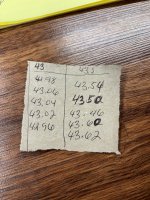Watching this thread as it appears my Lyman just shit the bed... Like 15 minutes ago.
Pulled the power cord and will let it set overnight just to be sure... But I'm thinking it's done.
Wanted to load a few rounds to verify a load and had to break out the beam scale.
I may actually regress back to a beam scale if I can find a good quality one... And just buy a throw for the high volume stuff and verify it every X number of rounds with the beam.
Not sure I need the resolution discussed here. But I'll definitely keep an open mind.
Mike
Pulled the power cord and will let it set overnight just to be sure... But I'm thinking it's done.
Wanted to load a few rounds to verify a load and had to break out the beam scale.
I may actually regress back to a beam scale if I can find a good quality one... And just buy a throw for the high volume stuff and verify it every X number of rounds with the beam.
Not sure I need the resolution discussed here. But I'll definitely keep an open mind.
Mike


